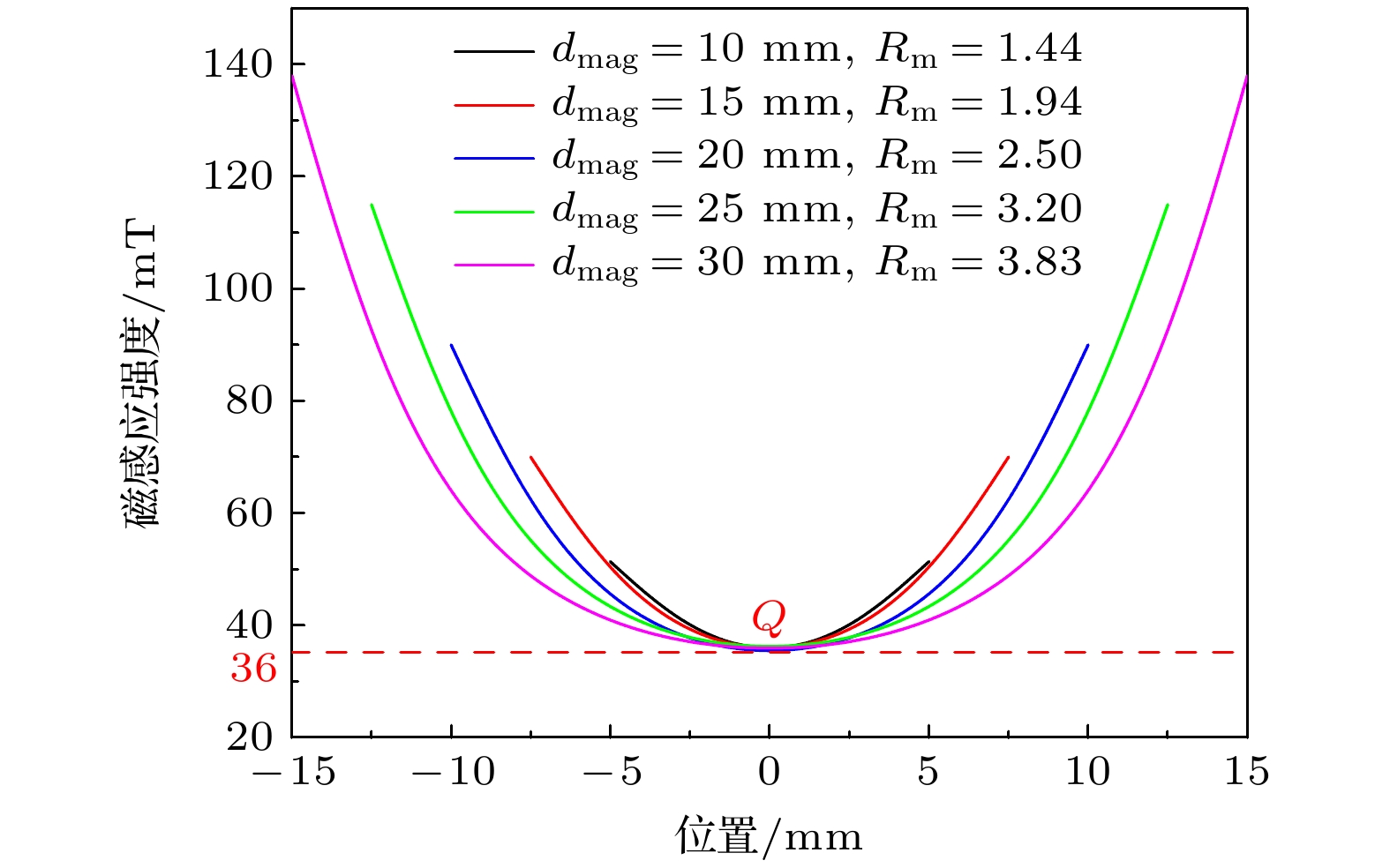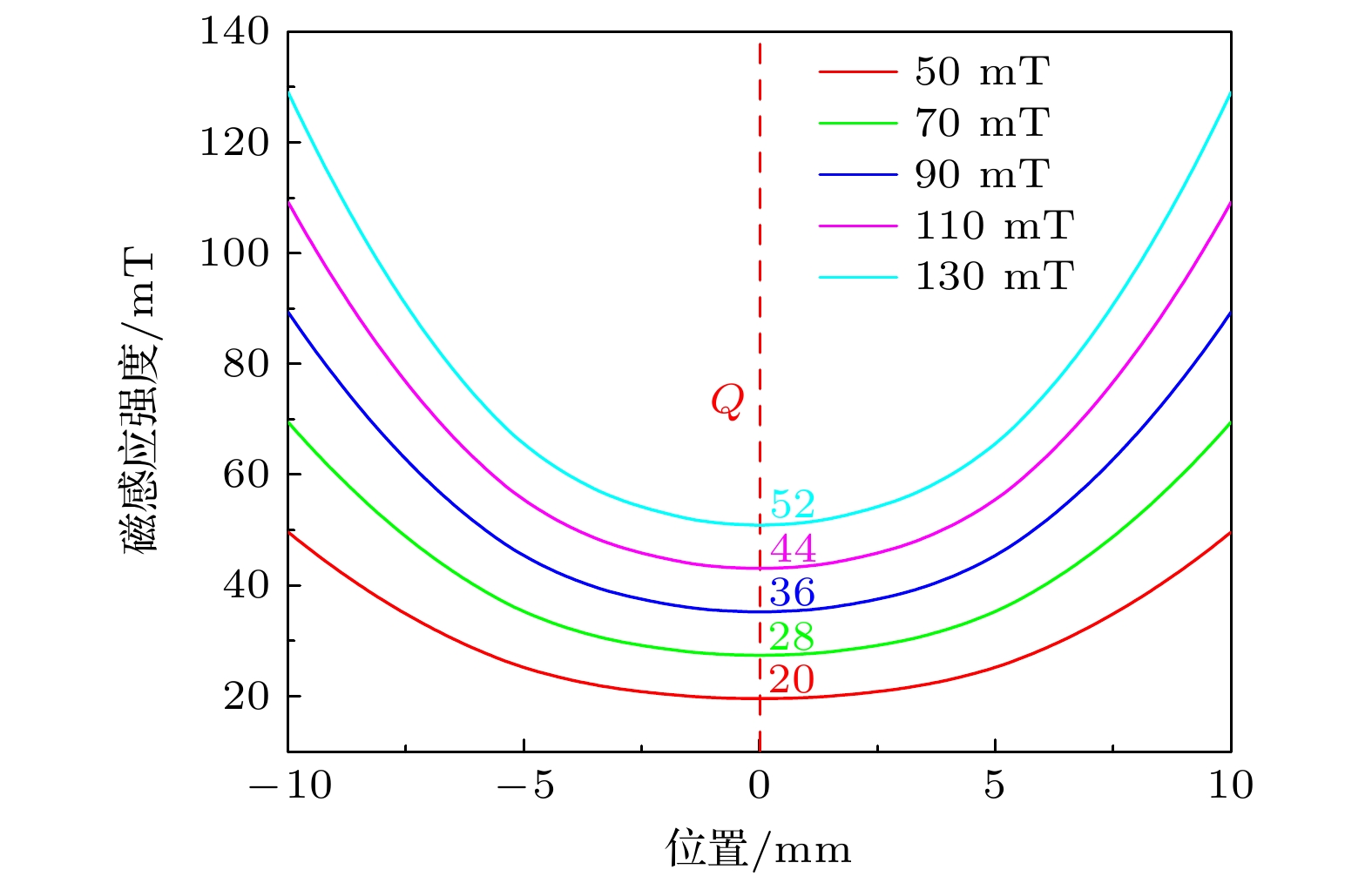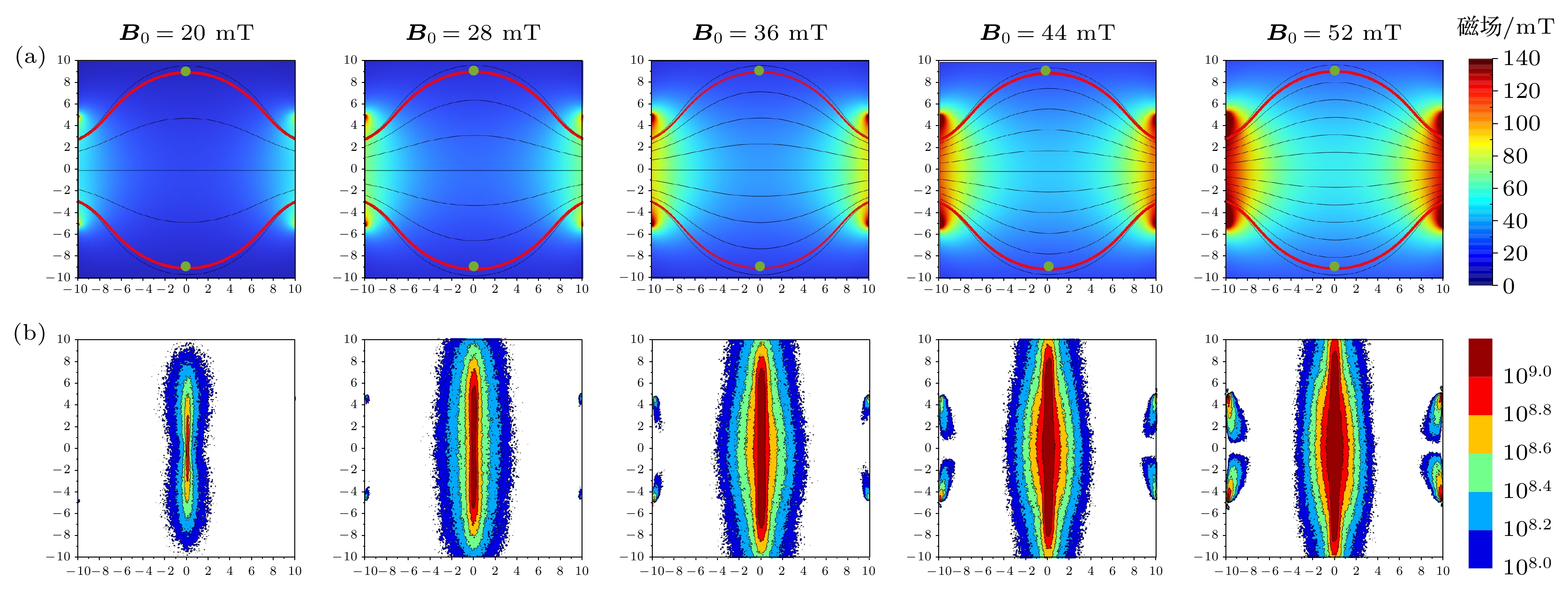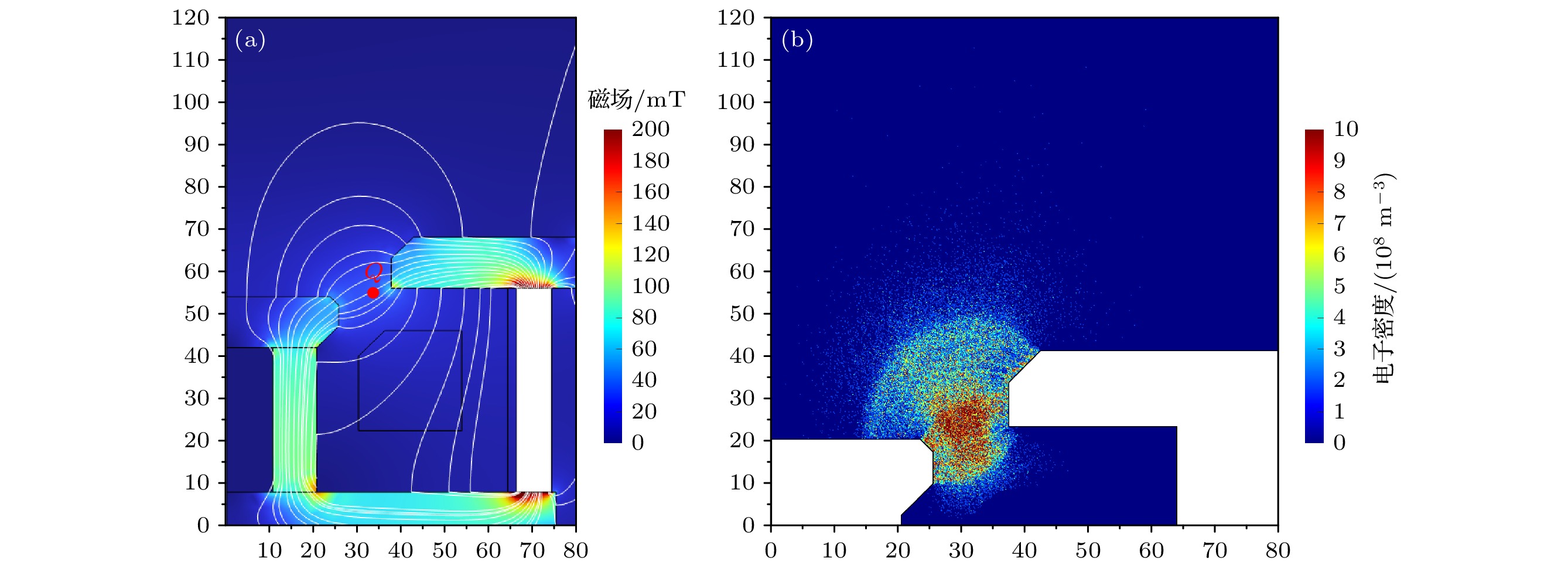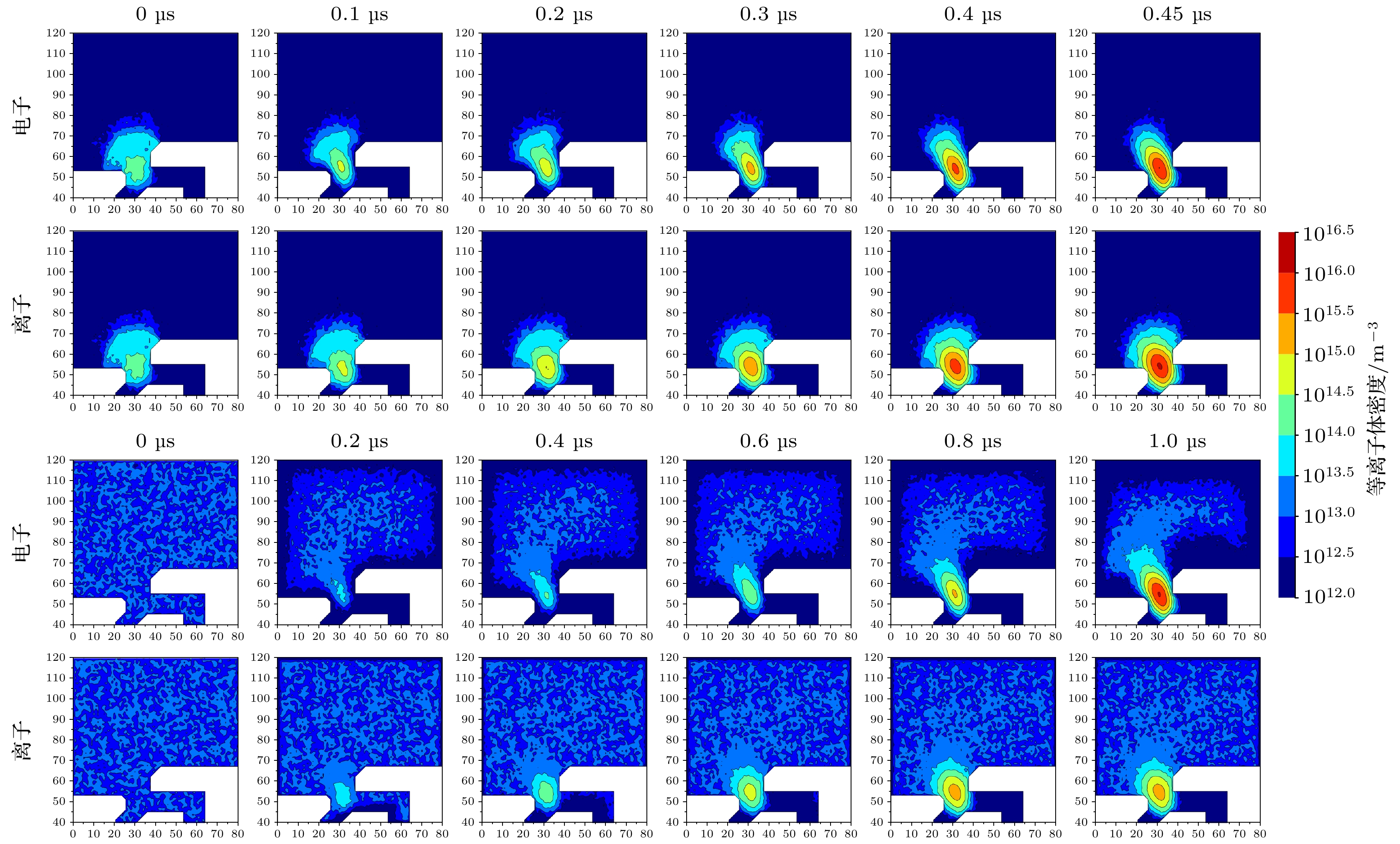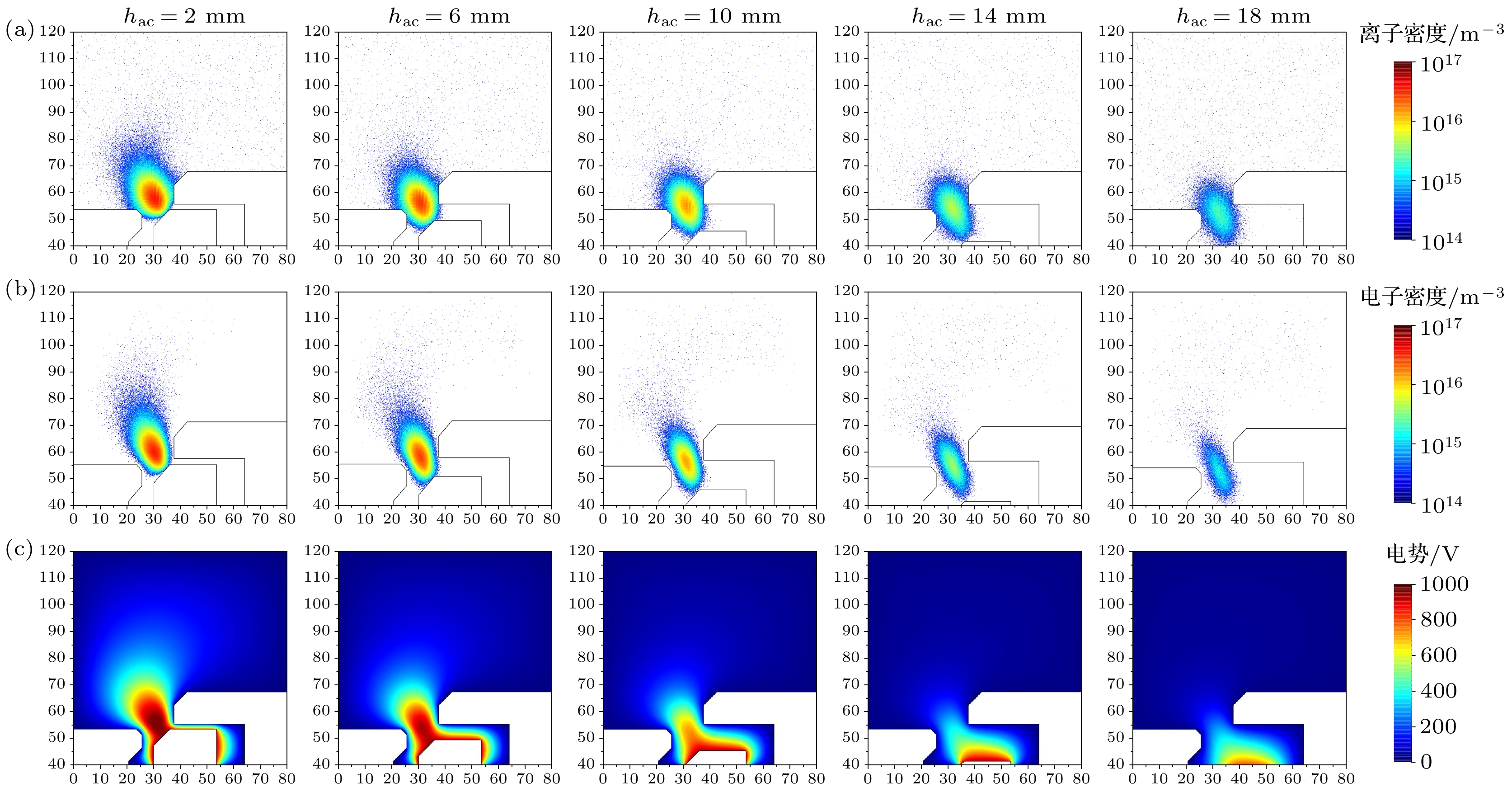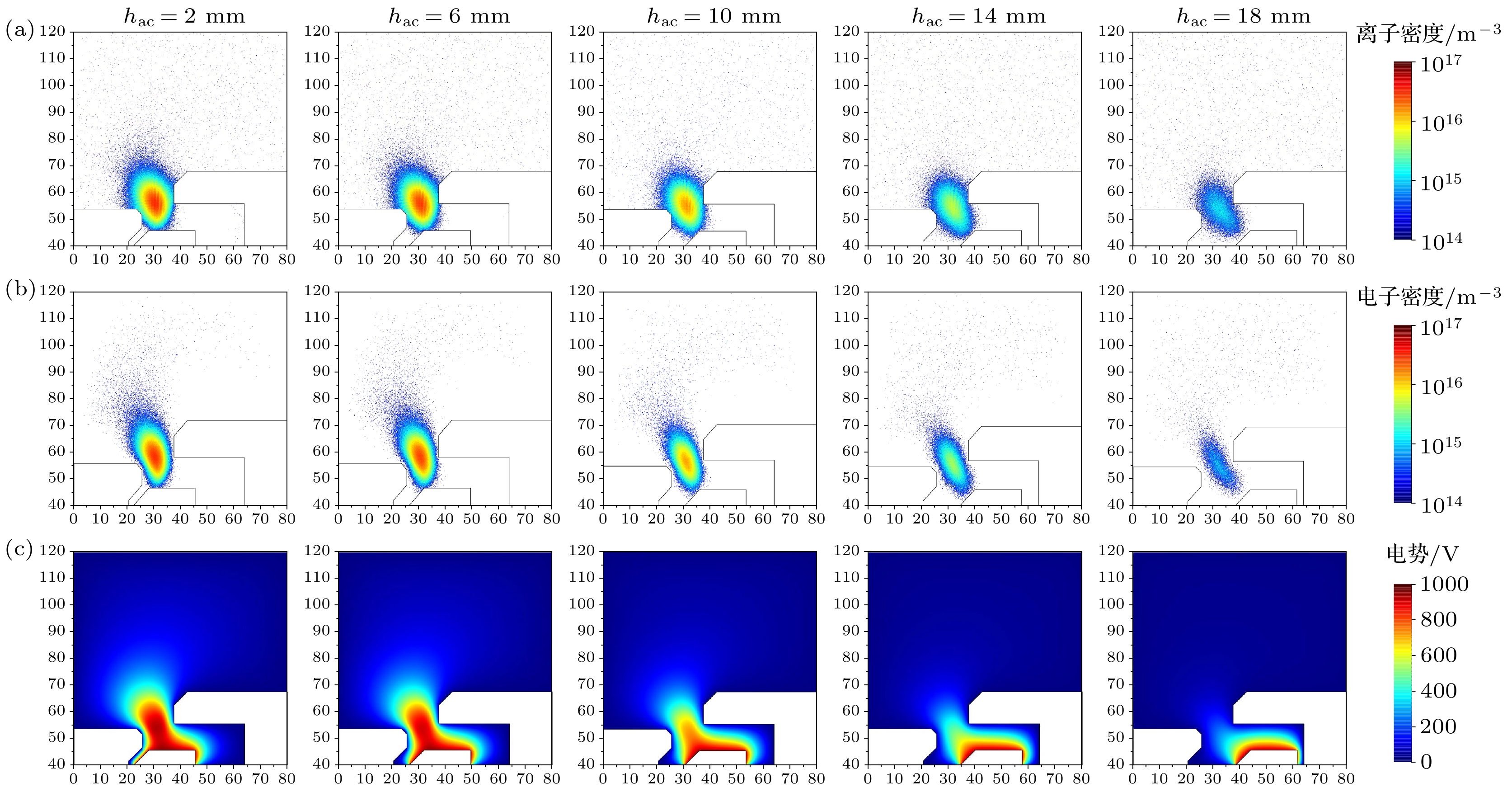-
等离子体仿真是研究等离子体放电特性的重要手段, 特别是阳极层离子源, 其放电结构的几何特性对等离子体特性的作用很难通过实验手段进行系统研究. 然而, 传统仿真模型一般是针对离子源进行整体建模, 离子源的阴阳极几何轮廓形成的复杂求解域, 导致模型的计算效率和收敛性较差. 鉴于此, 将离子源结构仿真与等离子体仿真分离, 首先利用磁镜原理将离子源内外阴极大小、形状和相对位置等一系列阴极几何参数简化为磁镜比Rm和磁镜中心磁感应强度 B 0两个磁镜参数, 并在此基础上, 建立了高效粒子网格/蒙特卡罗模型, 将收敛时间由1.00 μs缩短到0.45 μs, 大幅提升了计算效率和稳定性. 进一步利用该模型系统研究了阳极层离子源放电结构的几何特性对等离子体特性的影响规律, 发现Rm = 2.50, B 0 = 36 mT时磁镜对等离子体约束效果最佳, 当放电中心的位置与内外阴极间磁镜中心重合时, 不仅能够输出高密度离子束流, 同时可大幅减少阴极刻蚀, 并保证内外阴极的刻蚀平衡.Plasma simulation is important in studying the plasma discharge systematically, especially the anode layer ion source which has the complex geometrical characteristics of the discharge structure. However, owing to the complex solution domain formed by the geometric profile of the anode and cathode, the traditional simulation models show extremely small computational efficiency and poor convergence. This work presents a separate simulation for the ion source structure and the plasma discharge, separately, where the cathode geometric parameters (including the size, the shape and the relative position of the inner and outer cathodes) are simplified into two magnetic mirror parameters (the magnetic mirror ratio Rm and the magnetic induction intensity in the center of the magnetic mirror B 0), and then a high-efficient particle-in-cell/Monte Carlo collision (PIC/MCC) model is established to improve the computational efficiency and stability of the plasma simulation later. As a result, the convergence time of the plasma simulation is shortened significantly from 1.00 μs to 0.45 μs, and by which the influences of the geometrical characteristics of the discharge structure on the plasma properties are systematically studied. The simulation results reveal that magnetic mirror with Rm = 2.50 and B 0 = 36 mT can best confine the plasma in the central area between the inner cathode and outer cathode. When the discharge center of the plasmacoincides with the magnetic mirror center, the anode layer ion source presents both high density output of ion beam current and significantly reduced cathode etching, suggesting that the best balance is obtained between the output and cathode etching.
-
Keywords:
- plasma simulation /
- anode layer ion source /
- discharge structure /
- plasma properties
[1] Harper J M E, Cuomo J J, Kaufman H R 1982 J. Vac. Sci. Technol. A 21 737
 Google Scholar
Google Scholar
[2] 赵杰, 唐德礼, 程昌明, 耿少飞 2009 核聚变与等离子体物理 29 5
 Google Scholar
Google Scholar
Zhao J, Tang D L, Cheng C M, Geng S F 2009 Nucl. Fusion. Plasma. Phys. 29 5
 Google Scholar
Google Scholar
[3] Lee S, Kim J K, Kim D G 2012 Rev. Sci. Instrum. 83 02B703
 Google Scholar
Google Scholar
[4] Lieberman M A 1989 J. Appl. Phys. 66 2926
 Google Scholar
Google Scholar
[5] Gudmundsson J T 2020 Plasma Sources Sci. Technol. 29 113001
 Google Scholar
Google Scholar
[6] Birdsall C K 1991 IEEE Trans Plasma Sci. 19 65
 Google Scholar
Google Scholar
[7] Costin C, Marques L, Popa G, Gousset G 2005 Plasma Sources Sci. Technol. 14 168
 Google Scholar
Google Scholar
[8] Wood B P 1993 J. Appl. Phys. 73 4770
 Google Scholar
Google Scholar
[9] Zheng B C, Meng D, Che H L, Lei M K 2015 J. Appl. Phys. 117 203302
 Google Scholar
Google Scholar
[10] Raadu M A, Axnas I, Gudmundsson J T, Huo C, Brenning N 2011 Plasma Sources Sci. Technol. 20 065007
 Google Scholar
Google Scholar
[11] Boeuf J P, Chaudhury B 2013 Phys. Rev. Lett. 111 155005
 Google Scholar
Google Scholar
[12] Shah M, Chaudhury B, Bandyopadhyay M, Chakraborty A 2020 Fusion Eng. Des. 151 111402
 Google Scholar
Google Scholar
[13] Mattox D M 2001 Plat. Surf. Finish. 88 74
[14] Bogaerts A, Bultinck E, Kolev I, Schwaederle L, Van Aeken K, Buyle G, Depla D 2009 J. Phys. D:Appl. Phys. 42 194018
 Google Scholar
Google Scholar
[15] Kim H C, Iza F, Radmilovíc-Radjenovíc M, Lee J K 2005 J. Phys. D: Appl. Phys. 38 R283
 Google Scholar
Google Scholar
[16] Geng S F, Qiu X M, Cheng C M, Chu P K, Tang D L 2012 Phys. Plasmas 19 043507
 Google Scholar
Google Scholar
[17] Gui B, Yang L, Zhou H, Luo S, Xu J, Ma Z, Zhang Y 2022 Vacuum 200 111065
 Google Scholar
Google Scholar
[18] 冉彪, 李刘合 2018 真空 55 51
 Google Scholar
Google Scholar
Ran B, Li L H 2018 Vacuum 55 51
 Google Scholar
Google Scholar
[19] Jiang Y, Tang H, Ren J, Li M, Cao J 2018 J. Phys. D:Appl. Phys 51 035201
 Google Scholar
Google Scholar
[20] Yu D R, Zhang F K, Liu H, Li H, Yan G J, Liu J Y 2008 Phys. Plasmas. 15 104501
 Google Scholar
Google Scholar
[21] 谢树艺 2012 工程数学矢量分析与场论 (第4卷) (北京: 高等教育出版社) 第29—35页
Xie S Y 2012 Vector Analysis and Field Theory in Engineering Mathematics (Vol. 4) (Beijing: Higher Education Press) pp29–35 (in Chinese)
[22] Rossnagel S M, Kaufman H R 1987 J. Vac. Sci. Technol. A:Vac. Surf. Films 5 2276
 Google Scholar
Google Scholar
[23] Rossnagel S M, Kaufman H R 1988 J. Vac. Sci. Technol. A:Vac. Surf. Films 6 223
 Google Scholar
Google Scholar
[24] 弗朗西斯 F. 陈 著 (林光海 译) 1980 等离子体物理学导论(北京: 科学出版社) 第5—7页
Francis F. Chen(translated by Lin G H)1980 Introduction to Plasma Physics (Beijing: Science Press) pp5–7 (in Chinese)
[25] 崔岁寒, 郭宇翔, 陈秋皓, 金正, 杨超, 吴忠灿, 苏雄宇, 马正永, 田修波, 吴忠振 2022 物理学报 71 055203
 Google Scholar
Google Scholar
Cui S H, Guo Y X, Chen Q H, Jin Z, Yang C, Wu Z C, Su X Y, Ma Z Y, Tian X B, Wu Z Z 2022 Acta Phys. Sin. 71 055203
 Google Scholar
Google Scholar
[26] Shidoji E, Ohtake H, Nakano N, Makabe T 1999 Jpn. J. Appl. Phys. 38 2131
 Google Scholar
Google Scholar
[27] Chen L, Cui S H, Tang W, Zhou L, Li T, Liu L, An X, Wu Z, Ma Z, Lin H 2020 Plasma. Sources. Sci. T. 29 025016
 Google Scholar
Google Scholar
[28] Lennon M A, Bell K L, Gilbody H B, Hughes J G, Kingston A E, Murray M J, Smith F J 1988 J. Phys. Chem. Ref. Data. 17 1285
 Google Scholar
Google Scholar
[29] Yu W, Zhang L Z, Wang J L, Han L, Fu G S 2001 J. Phys. D: Appl. Phys. 34 3349
 Google Scholar
Google Scholar
[30] Samuelsson M, Lundin D, Jensen J, Raadu M A, Gudmundsson J T, Helmersson U 2010 Surf. Coat. Tech. 205 591
 Google Scholar
Google Scholar
[31] Vahedi V, Surendra M 1995 Comput. Phys. Commun. 87 179
 Google Scholar
Google Scholar
[32] Gong W Y 2009 M. S. Thesis (Chengdu: University of Elecdtronic Science and Technology of China) (in Chinese)
[33] Cui S H, Chen Q H, Guo Y X, Chen L, Jin Z, Li X T, Yang C, Wu Z C, Su X Y, Ma Z Y, Ricky K Y Fu, Tian X B, Paul K Chu, Wu Z Z 2022 J. Phys. D: Appl. Phys. 55 325203
 Google Scholar
Google Scholar
[34] 王忆锋, 唐利斌 2010 红外技术 32 213
 Google Scholar
Google Scholar
Wang Y F, Tang L B 2010 Infrared Tech. 32 213
 Google Scholar
Google Scholar
[35] Olesik J, Całusiński B 1994 Thin Solid Films 238 271
 Google Scholar
Google Scholar
[36] 汪礼胜, 唐德礼, 程昌明 2006 核聚变与等离子体物理 26 54
 Google Scholar
Google Scholar
Wang L S, Tang D L, Cheng C M 2006 Nucl. Fusion. Plasma. Phys. 26 54
 Google Scholar
Google Scholar
[37] 陈志国 2021 硕士学位论文 (哈尔滨: 哈尔滨工业大学)
Chen Z G 2021 M. S. Thesis (Harbin: Harbin Institute of Technology) (in Chinese)
-
反应方程式 反应速率系数kr/(m3⋅s–1 ) 反应能量阈值/eV 反应类型 e + Ar → Ar + e $2.336 \times {10^{ - 14} }{T_{\text{e} } }^{1.609} \times \exp \big[ {0.0618{ {\left( {\ln {T_{\text{e} } } } \right)}^2} - 0.1171{ {\left( {\ln {T_{\text{e} } } } \right)}^3} } \big]$ — 弹性碰撞 e + Ar → Ar+ + 2e $2.34 \times {10^{ - 14} }{T_{\text{e} } }^{0.59} \times \exp \left( { - 17.44/{T_{\text{e} } } } \right)$ 15.76 电离碰撞 反应方程式 反应类型 Ar+ + Ar → Ar+ + Ar 弹性碰撞 Ar+ + Ar → Ar + Ar+ 电荷交换 反应方程式 反应速率系数 kr/(m3⋅s–1) 反应能量阈值/eV 反应类型 e + Ar → Ar + e $ 2.336 \times {10^{ - 14}}{T_{\text{e}}}^{1.609} \times \exp \left[ {0.0618{{\left( {\ln {T_{\text{e}}}} \right)}^2} - 0.1171{{\left( {\ln {T_{\text{e}}}} \right)}^3}} \right] $ — 弹性碰撞 e + Ar → Ar+ + 2e $ 2.34 \times {10^{ - 14}}{T_{\text{e}}}^{0.59} \times \exp \left( { - 17.44/{T_{\text{e}}}} \right) $ 15.76 电离碰撞 e + Ar → Arm + e $ 2.5 \times {10^{ - 15}}{T_{\text{e}}}^{0.74} \times \exp \left( { - 11.56/{T_{\text{e}}}} \right) $ 11.56 激发碰撞 e + Arm → Ar+ + 2e $ 6.8 \times {10^{ - 15}}{T_{\text{e}}}^{0.67} \times \exp \left( { - 4.2/{T_{\text{e}}}} \right) $ 4.20 激发态电离 e + Arm → Ar + e $ 4.3 \times {10^{ - 16}}{T_{\text{e}}}^{0.74} $ –11.56 退激发碰撞 Ar+ + Ar → Ar+ + Ar 硬球模型 — 弹性碰撞 Ar+ + Ar → Ar + Ar+ 硬球模型 — 电荷交换 表 4 不同hac对应的等离子体放电特性
Table 4. Plasma discharge characteristics at different hac.
hac/mm 阴极溅射离
子占比/%输出离子
占比/%输出离子数/阴
极溅射离子数等离子体峰值
密度/(1016 m–3)放电中心坐标/mm 放电面积/mm2 2 53.8 43.8 0.81 4.02 (31.1, 57.9) 209.3 6 51.8 47.0 0.91 3.06 (31.3, 55.8) 188.0 10 40.6 59.3 1.46 1.78 (31.6, 54.8) 155.0 14 34.4 65.6 1.90 0.68 (32.1, 53.6) 90.0 18 24.3 75.6 3.10 0.34 (32.8, 52.9) 38.4 表 5 不同dac对应的等离子体特性
Table 5. Plasma properties at different dac.
dac/mm 阴极溅射离
子占比/%输出离子
占比/%输出离子数/阴
极溅射离子数内外阴极溅
射强度比等离子体峰值密
度/(1016 m–3)放电中心
坐标/mm放电面积/mm2 2 51.0 47.5 0.93 1.38 3.72 (31.3, 55.9) 208.4 6 48.1 50.9 1.06 1.19 3.26 (31.4, 55.4) 199.5 10 40.6 59.3 1.46 0.99 1.78 (31.6, 54.8) 155.0 14 32.8 67.2 2.05 0.74 0.72 (31.7, 53.8) 103.1 18 25.7 74.2 2.88 0.52 0.26 (33.4, 53.4) 14.2 -
[1] Harper J M E, Cuomo J J, Kaufman H R 1982 J. Vac. Sci. Technol. A 21 737
 Google Scholar
Google Scholar
[2] 赵杰, 唐德礼, 程昌明, 耿少飞 2009 核聚变与等离子体物理 29 5
 Google Scholar
Google Scholar
Zhao J, Tang D L, Cheng C M, Geng S F 2009 Nucl. Fusion. Plasma. Phys. 29 5
 Google Scholar
Google Scholar
[3] Lee S, Kim J K, Kim D G 2012 Rev. Sci. Instrum. 83 02B703
 Google Scholar
Google Scholar
[4] Lieberman M A 1989 J. Appl. Phys. 66 2926
 Google Scholar
Google Scholar
[5] Gudmundsson J T 2020 Plasma Sources Sci. Technol. 29 113001
 Google Scholar
Google Scholar
[6] Birdsall C K 1991 IEEE Trans Plasma Sci. 19 65
 Google Scholar
Google Scholar
[7] Costin C, Marques L, Popa G, Gousset G 2005 Plasma Sources Sci. Technol. 14 168
 Google Scholar
Google Scholar
[8] Wood B P 1993 J. Appl. Phys. 73 4770
 Google Scholar
Google Scholar
[9] Zheng B C, Meng D, Che H L, Lei M K 2015 J. Appl. Phys. 117 203302
 Google Scholar
Google Scholar
[10] Raadu M A, Axnas I, Gudmundsson J T, Huo C, Brenning N 2011 Plasma Sources Sci. Technol. 20 065007
 Google Scholar
Google Scholar
[11] Boeuf J P, Chaudhury B 2013 Phys. Rev. Lett. 111 155005
 Google Scholar
Google Scholar
[12] Shah M, Chaudhury B, Bandyopadhyay M, Chakraborty A 2020 Fusion Eng. Des. 151 111402
 Google Scholar
Google Scholar
[13] Mattox D M 2001 Plat. Surf. Finish. 88 74
[14] Bogaerts A, Bultinck E, Kolev I, Schwaederle L, Van Aeken K, Buyle G, Depla D 2009 J. Phys. D:Appl. Phys. 42 194018
 Google Scholar
Google Scholar
[15] Kim H C, Iza F, Radmilovíc-Radjenovíc M, Lee J K 2005 J. Phys. D: Appl. Phys. 38 R283
 Google Scholar
Google Scholar
[16] Geng S F, Qiu X M, Cheng C M, Chu P K, Tang D L 2012 Phys. Plasmas 19 043507
 Google Scholar
Google Scholar
[17] Gui B, Yang L, Zhou H, Luo S, Xu J, Ma Z, Zhang Y 2022 Vacuum 200 111065
 Google Scholar
Google Scholar
[18] 冉彪, 李刘合 2018 真空 55 51
 Google Scholar
Google Scholar
Ran B, Li L H 2018 Vacuum 55 51
 Google Scholar
Google Scholar
[19] Jiang Y, Tang H, Ren J, Li M, Cao J 2018 J. Phys. D:Appl. Phys 51 035201
 Google Scholar
Google Scholar
[20] Yu D R, Zhang F K, Liu H, Li H, Yan G J, Liu J Y 2008 Phys. Plasmas. 15 104501
 Google Scholar
Google Scholar
[21] 谢树艺 2012 工程数学矢量分析与场论 (第4卷) (北京: 高等教育出版社) 第29—35页
Xie S Y 2012 Vector Analysis and Field Theory in Engineering Mathematics (Vol. 4) (Beijing: Higher Education Press) pp29–35 (in Chinese)
[22] Rossnagel S M, Kaufman H R 1987 J. Vac. Sci. Technol. A:Vac. Surf. Films 5 2276
 Google Scholar
Google Scholar
[23] Rossnagel S M, Kaufman H R 1988 J. Vac. Sci. Technol. A:Vac. Surf. Films 6 223
 Google Scholar
Google Scholar
[24] 弗朗西斯 F. 陈 著 (林光海 译) 1980 等离子体物理学导论(北京: 科学出版社) 第5—7页
Francis F. Chen(translated by Lin G H)1980 Introduction to Plasma Physics (Beijing: Science Press) pp5–7 (in Chinese)
[25] 崔岁寒, 郭宇翔, 陈秋皓, 金正, 杨超, 吴忠灿, 苏雄宇, 马正永, 田修波, 吴忠振 2022 物理学报 71 055203
 Google Scholar
Google Scholar
Cui S H, Guo Y X, Chen Q H, Jin Z, Yang C, Wu Z C, Su X Y, Ma Z Y, Tian X B, Wu Z Z 2022 Acta Phys. Sin. 71 055203
 Google Scholar
Google Scholar
[26] Shidoji E, Ohtake H, Nakano N, Makabe T 1999 Jpn. J. Appl. Phys. 38 2131
 Google Scholar
Google Scholar
[27] Chen L, Cui S H, Tang W, Zhou L, Li T, Liu L, An X, Wu Z, Ma Z, Lin H 2020 Plasma. Sources. Sci. T. 29 025016
 Google Scholar
Google Scholar
[28] Lennon M A, Bell K L, Gilbody H B, Hughes J G, Kingston A E, Murray M J, Smith F J 1988 J. Phys. Chem. Ref. Data. 17 1285
 Google Scholar
Google Scholar
[29] Yu W, Zhang L Z, Wang J L, Han L, Fu G S 2001 J. Phys. D: Appl. Phys. 34 3349
 Google Scholar
Google Scholar
[30] Samuelsson M, Lundin D, Jensen J, Raadu M A, Gudmundsson J T, Helmersson U 2010 Surf. Coat. Tech. 205 591
 Google Scholar
Google Scholar
[31] Vahedi V, Surendra M 1995 Comput. Phys. Commun. 87 179
 Google Scholar
Google Scholar
[32] Gong W Y 2009 M. S. Thesis (Chengdu: University of Elecdtronic Science and Technology of China) (in Chinese)
[33] Cui S H, Chen Q H, Guo Y X, Chen L, Jin Z, Li X T, Yang C, Wu Z C, Su X Y, Ma Z Y, Ricky K Y Fu, Tian X B, Paul K Chu, Wu Z Z 2022 J. Phys. D: Appl. Phys. 55 325203
 Google Scholar
Google Scholar
[34] 王忆锋, 唐利斌 2010 红外技术 32 213
 Google Scholar
Google Scholar
Wang Y F, Tang L B 2010 Infrared Tech. 32 213
 Google Scholar
Google Scholar
[35] Olesik J, Całusiński B 1994 Thin Solid Films 238 271
 Google Scholar
Google Scholar
[36] 汪礼胜, 唐德礼, 程昌明 2006 核聚变与等离子体物理 26 54
 Google Scholar
Google Scholar
Wang L S, Tang D L, Cheng C M 2006 Nucl. Fusion. Plasma. Phys. 26 54
 Google Scholar
Google Scholar
[37] 陈志国 2021 硕士学位论文 (哈尔滨: 哈尔滨工业大学)
Chen Z G 2021 M. S. Thesis (Harbin: Harbin Institute of Technology) (in Chinese)
计量
- 文章访问数: 9054
- PDF下载量: 142
- 被引次数: 0













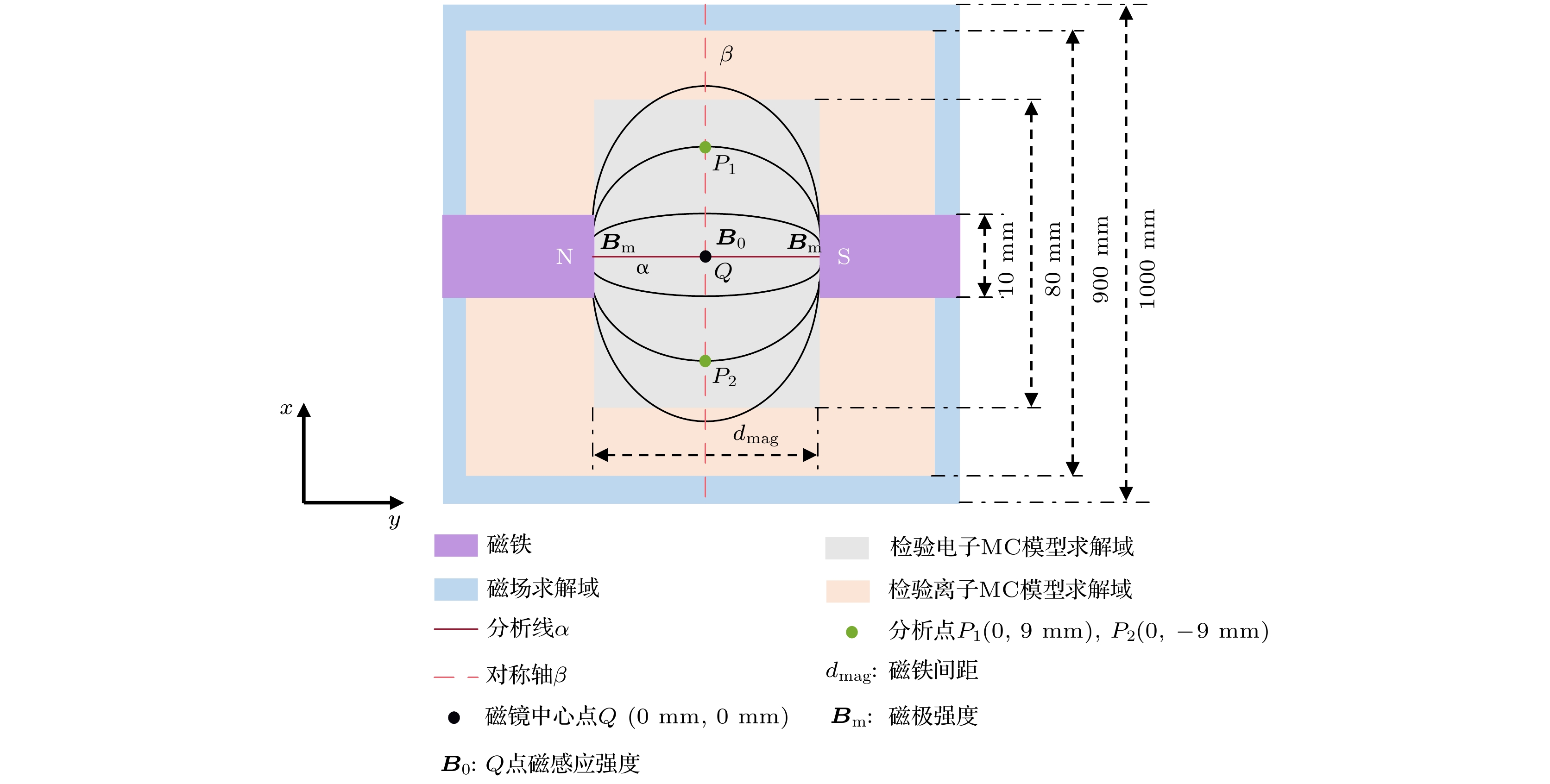
 下载:
下载:

